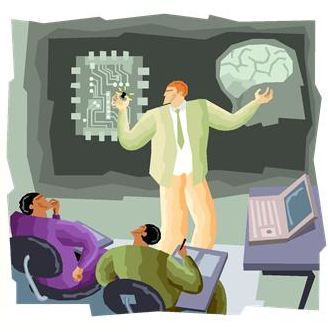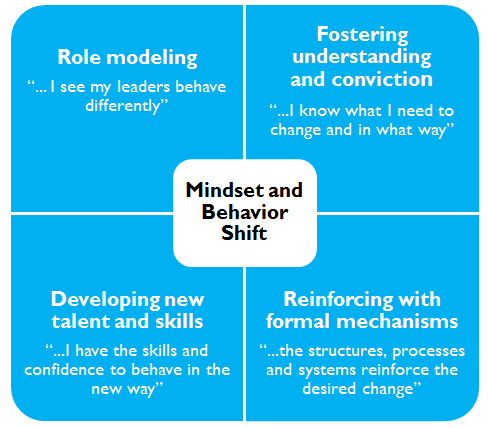
Changing people’s behaviors can be done in one of two ways, generally speaking. You can force behavior change through management decree or you can change the mindsets of people so that their thinking results in new desired behaviors. We have seen both approaches used by leaders at different organizations. Not surprisingly, altering mindsets is more effective at sustaining change over the long term. The drawback is that it takes additional time and effort to properly effect a change in mindset.
When the necessary time and effort is invested, a person’s mindset can lead them to take actions (behaviors) necessary to foster momentum and a critical mass of commitment throughout the organization. There are a few fundamental methods that can help accelerate people changing their mindsets and ultimately their behaviors.
- Role modeling: It is important for leaders to understand how a mindset and its associated behaviors can either enable or hinder successful implementation of the company’s strategic initiatives. Leaders will need to model new behavior patterns, often in high-profile ways, in order to achieve the desired future state.
- Fostering understanding and conviction: This is where the case for change plays a key role. The change story should paint the picture of a future that is more attractive than the present, and demonstrate clearly how the desired change in mindset and behavior will enable people to accomplish it. For example, improving returns to shareholders isn’t that future, but building a great company, being part of a high-performing team, and achieving more than they thought possible is.
 Developing talent and skills: People are more open to changing their mindsets and trying out new behaviors if they know leaders are willing to invest in their futures with the organization. One way to do this, while at the same time demonstrating good will, is by providing training and skill-building programs to help people adapt to the changes.
Developing talent and skills: People are more open to changing their mindsets and trying out new behaviors if they know leaders are willing to invest in their futures with the organization. One way to do this, while at the same time demonstrating good will, is by providing training and skill-building programs to help people adapt to the changes.
- Reinforcing with formal mechanisms: Change is easier for people when the environment around them is altered so as to reinforce new behaviors. For example, updating individuals’ business goals and incentives to align with the future state, then holding the individuals accountable using the appraisal process, can go a long way toward creating incentive that brings about desired mindsets and behaviors.
Finally, don’t underestimate the power of a positive mindset, as it has the potential to change performance by creating a self-fulfilling prophecy. Consider the elementary schoolteachers who were told at the beginning of the year that their students were “bloomers” and would show a significant jump in IQ. When tested at the end of the year, their score on the Stanford-Binet IQ test went up fifteen points on average. Actually, the students were no different from others—it was the teachers’ expectations that caused the increase.
Be sure to also check out our article on Secrets to Business Transformation Success.












5 comments
Pingback: Influencing Mindset and Behavior Change | the Change Samurai | Scoop.it
Pingback: The Senior Leader’s Role in Driving Transformation « Emergent Insights
Pingback: The Senior Leader’s Role in Driving Transformation | test
Pingback: » How to Use Storytelling Technique to Communicate Your Vision
Sandu
at 5:06 am
I need more information regarding this topic (Influencing Mindset and Behavior Change)because today working in Quality Mindset Change Department in metallurgy sector.
I am beginning, for me is new road but I ambitious and hard working.
Please help me change our organization and our behavior from the quality
Thank you !
Sandu